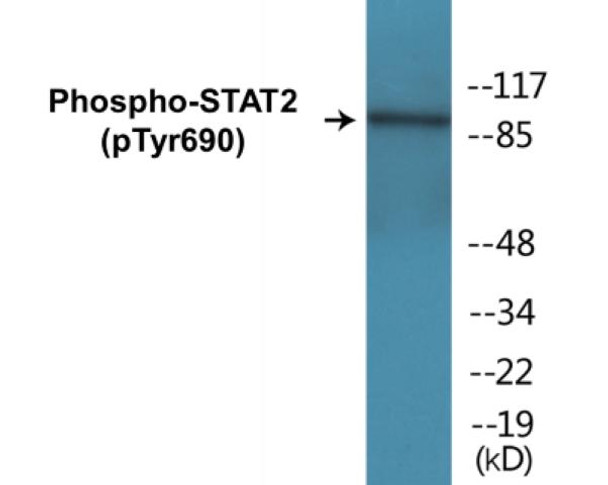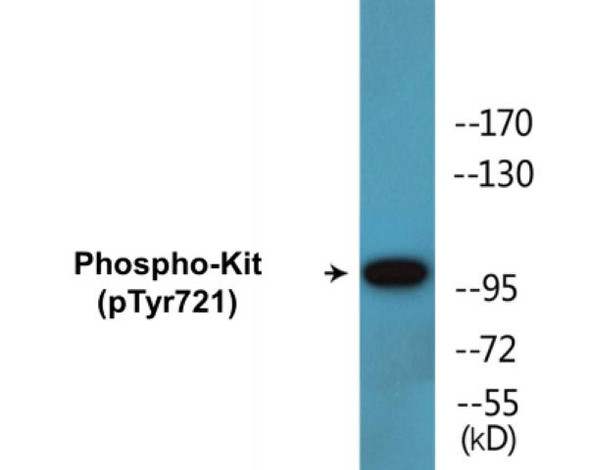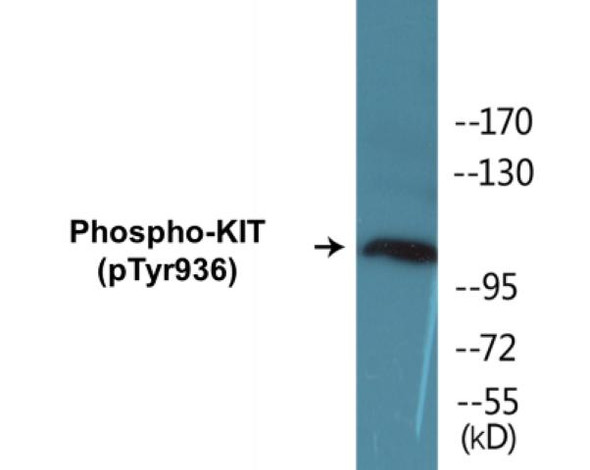Description
STAT2 (Phospho-Tyr690)Colorimetric Cell-Based ELISA Kit
The STAT2 Phospho-Tyr690 Colorimetric Cell-Based ELISA Kit is a comprehensive tool for the detection and quantification of phosphorylated STAT2 protein in cell lysates. This kit offers high sensitivity and specificity, allowing for accurate and reproducible results in a variety of research applications.STAT2 is a key transcription factor that plays a critical role in the regulation of immune responses and cellular signaling pathways. Phosphorylation of STAT2 at Tyr690 is essential for its activation and function in the nucleus, where it regulates the expression of genes involved in antiviral responses and immune modulation.
By studying the phosphorylation status of STAT2 at Tyr690, researchers can gain valuable insights into the mechanisms underlying immune responses, viral infections, and various diseases. The STAT2 Phospho-Tyr690 Colorimetric Cell-Based ELISA Kit provides a reliable and efficient method for analyzing STAT2 phosphorylation in cell-based assays, offering a valuable tool for advancing scientific discoveries and therapeutic development.
| Product Name: | STAT2 (Phospho-Tyr690) Colorimetric Cell-Based ELISA |
| Product Code: | CBCAB01252 |
| ELISA Type: | Cell-Based |
| Target: | STAT2 (Phospho-Tyr690) |
| Reactivity: | Human, Rat |
| Dynamic Range: | > 5000 Cells |
| Detection Method: | Colorimetric 450 nm |
| Format: | 2 x 96-Well Microplates |
The STAT2 (Phospho-Tyr690) Colorimetric Cell-Based ELISA Kit is a convenient, lysate-free, high throughput and sensitive assay kit that can detect STAT2 protein phosphorylation and expression profile in cells. The kit can be used for measuring the relative amounts of phosphorylated STAT2 in cultured cells as well as screening for the effects that various treatments, inhibitors (ie. siRNA or chemicals), or activators have on STAT2 phosphorylation.
Qualitative determination of STAT2 (Phospho-Tyr690) concentration is achieved by an indirect ELISA format. In essence, STAT2 (Phospho-Tyr690) is captured by STAT2 (Phospho-Tyr690)-specific primary (1ø) antibodies while the HRP-conjugated secondary (2ø) antibodies bind the Fc region of the 1ø antibody. Through this binding, the HRP enzyme conjugated to the 2ø antibody can catalyze a colorimetric reaction upon substrate addition. Due to the qualitative nature of the Cell-Based ELISA, multiple normalization methods are needed:
| 1. | A monoclonal antibody specific for human GAPDH is included to serve as an internal positive control in normalizing the target absorbance values. |
| 2. | Following the colorimetric measurement of HRP activity via substrate addition, the Crystal Violet whole-cell staining method may be used to determine cell density. After staining, the results can be analysed by normalizing the absorbance values to cell amounts, by which the plating difference can be adjusted. |
| Database Information: | Gene ID: 6773, UniProt ID: P52630, OMIM: 600556, Unigene: Hs.530595 |
| Gene Symbol: | STAT2 |
| Sub Type: | Phospho |
| UniProt Protein Function: | STAT2: transcription factor of the STAT family. Phosphorylated and activated by receptor-associated kinases downstream of many cytokines and growth-factor receptors. Binds to the IFN-stimulated response element (ISRE) and to the Gas element. This multiprotein transcription factor is termed ISGF3. Two alternatively spliced isoforms have been described. |
| UniProt Protein Details: | Protein type:DNA-binding; Transcription factor Chromosomal Location of Human Ortholog: 12q13.3 Cellular Component: cytoplasm; cytosol; nucleoplasm; plasma membrane Molecular Function:DNA binding; identical protein binding; protein binding; signal transducer activity; transcription factor activity Biological Process: cytokine and chemokine mediated signaling pathway; defense response to virus; JAK-STAT cascade; positive regulation of defense response to virus by host; regulation of transcription from RNA polymerase II promoter; transcription, DNA-dependent; viral reproduction |
| NCBI Summary: | The protein encoded by this gene is a member of the STAT protein family. In response to cytokines and growth factors, STAT family members are phosphorylated by the receptor associated kinases, and then form homo- or heterodimers that translocate to the cell nucleus where they act as transcription activators. In response to interferon (IFN), this protein forms a complex with STAT1 and IFN regulatory factor family protein p48 (ISGF3G), in which this protein acts as a transactivator, but lacks the ability to bind DNA directly. Transcription adaptor P300/CBP (EP300/CREBBP) has been shown to interact specifically with this protein, which is thought to be involved in the process of blocking IFN-alpha response by adenovirus. Multiple transcript variants encoding different isoforms have been found for this gene. [provided by RefSeq, Mar 2010] |
| UniProt Code: | P52630 |
| NCBI GenInfo Identifier: | 1711552 |
| NCBI Gene ID: | 6773 |
| NCBI Accession: | P52630.1 |
| UniProt Secondary Accession: | P52630,Q16430, Q16431, Q9UDL4, B4DLC7, G3V2M6, |
| UniProt Related Accession: | P52630 |
| Molecular Weight: | 97,457 Da |
| NCBI Full Name: | Signal transducer and activator of transcription 2 |
| NCBI Synonym Full Names: | signal transducer and activator of transcription 2 |
| NCBI Official Symbol: | STAT2 |
| NCBI Official Synonym Symbols: | P113; IMD44; ISGF-3; STAT113 |
| NCBI Protein Information: | signal transducer and activator of transcription 2 |
| UniProt Protein Name: | Signal transducer and activator of transcription 2 |
| UniProt Synonym Protein Names: | p113 |
| Protein Family: | Signal transducer and activator of transcription |
| UniProt Gene Name: | STAT2 |
| UniProt Entry Name: | STAT2_HUMAN |
| Component | Quantity |
| 96-Well Cell Culture Clear-Bottom Microplate | 2 plates |
| 10X TBS | 24 mL |
| Quenching Buffer | 24 mL |
| Blocking Buffer | 50 mL |
| 15X Wash Buffer | 50 mL |
| Primary Antibody Diluent | 12 mL |
| 100x Anti-Phospho Target Antibody | 60 µL |
| 100x Anti-Target Antibody | 60 µL |
| Anti-GAPDH Antibody | 60 µL |
| HRP-Conjugated Anti-Rabbit IgG Antibody | 12 mL |
| HRP-Conjugated Anti-Mouse IgG Antibody | 12 mL |
| SDS Solution | 12 mL |
| Stop Solution | 24 mL |
| Ready-to-Use Substrate | 12 mL |
| Crystal Violet Solution | 12 mL |
| Adhesive Plate Seals | 2 seals |
The following materials and/or equipment are NOT provided in this kit but are necessary to successfully conduct the experiment:
- Microplate reader able to measure absorbance at 450 nm and/or 595 nm for Crystal Violet Cell Staining (Optional)
- Micropipettes with capability of measuring volumes ranging from 1 µL to 1 ml
- 37% formaldehyde (Sigma Cat# F-8775) or formaldehyde from other sources
- Squirt bottle, manifold dispenser, multichannel pipette reservoir or automated microplate washer
- Graph paper or computer software capable of generating or displaying logarithmic functions
- Absorbent papers or vacuum aspirator
- Test tubes or microfuge tubes capable of storing ≥1 ml
- Poly-L-Lysine (Sigma Cat# P4832 for suspension cells)
- Orbital shaker (optional)
- Deionized or sterile water
*Note: Protocols are specific to each batch/lot. For the correct instructions please follow the protocol included in your kit.
| Step | Procedure |
| 1. | Seed 200 µL of 20,000 adherent cells in culture medium in each well of a 96-well plate. The plates included in the kit are sterile and treated for cell culture. For suspension cells and loosely attached cells, coat the plates with 100 µL of 10 µg/ml Poly-L-Lysine (not included) to each well of a 96-well plate for 30 minutes at 37 °C prior to adding cells. |
| 2. | Incubate the cells for overnight at 37 °C, 5% CO2. |
| 3. | Treat the cells as desired. |
| 4. | Remove the cell culture medium and rinse with 200 µL of 1x TBS, twice. |
| 5. | Fix the cells by incubating with 100 µL of Fixing Solution for 20 minutes at room temperature. The 4% formaldehyde is used for adherent cells and 8% formaldehyde is used for suspension cells and loosely attached cells. |
| 6. | Remove the Fixing Solution and wash the plate 3 times with 200 µL 1x Wash Buffer for five minutes each time with gentle shaking on the orbital shaker. The plate can be stored at 4 °C for a week. |
| 7. | Add 100 µL of Quenching Buffer and incubate for 20 minutes at room temperature. |
| 8. | Wash the plate 3 times with 1x Wash Buffer for 5 minutes each time. |
| 9. | Add 200 µL of Blocking Buffer and incubate for 1 hour at room temperature. |
| 10. | Wash 3 times with 200 µL of 1x Wash Buffer for 5 minutes each time. |
| 11. | Add 50 µL of 1x primary antibodies Anti-STAT2 (Phospho-Tyr690) Antibody, Anti-STAT2 Antibody and/or Anti-GAPDH Antibody) to the corresponding wells, cover with Parafilm and incubate for 16 hours (overnight) at 4 °C. If the target expression is known to be high, incubate for 2 hours at room temperature. |
| 12. | Wash 3 times with 200 µL of 1x Wash Buffer for 5 minutes each time. |
| 13. | Add 50 µL of 1x secondary antibodies (HRP-Conjugated AntiRabbit IgG Antibody or HRP-Conjugated Anti-Mouse IgG Antibody) to corresponding wells and incubate for 1.5 hours at room temperature. |
| 14. | Wash 3 times with 200 µL of 1x Wash Buffer for 5 minutes each time. |
| 15. | Add 50 µL of Ready-to-Use Substrate to each well and incubate for 30 minutes at room temperature in the dark. |
| 16. | Add 50 µL of Stop Solution to each well and read OD at 450 nm immediately using the microplate reader. |
(Additional Crystal Violet staining may be performed if desired – details of this may be found in the kit technical manual.)






